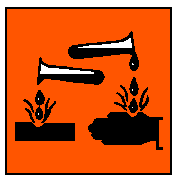International Chemical Safety Cards
| SODIUM HYPOCHLORITE (SOLUTION, ACTIVE CHLORINE >5%) | ICSC: 1119 |
SODIUM HYPOCHLORITE (SOLUTION, ACTIVE CHLORINE >5%) |
 |
| TYPES OF HAZARD/ EXPOSURE |
ACUTE HAZARDS/ SYMPTOMS |
PREVENTION | FIRST AID/ FIRE FIGHTING |
| FIRE | Not combustible. Many reactions
may cause fire or explosion. Heating will cause rise in pressure with risk of bursting.
Gives off irritating or toxic fumes (or gases) in a fire. |
NO contact with combustible
substances (see Chemical Dangers). |
|
| EXPLOSION | |
|
In case of fire: keep drums,
etc., cool by spraying with water. |
| EXPOSURE | |
AVOID ALL CONTACT! |
|
| INHALATION | Corrosive. Burning sensation.
Cough. Shortness of breath. |
Ventilation, local exhaust, or
breathing protection. |
Fresh air, rest. Half-upright
position. Refer for medical attention. |
| SKIN | Corrosive. Redness. Pain.
Blisters. |
Protective gloves. Protective
clothing. |
First rinse with plenty of
water, then remove contaminated clothes and rinse again. Refer for medical attention. |
| EYES | Corrosive. Redness. Pain.
Severe deep burns. |
Face shield or eye protection
in combination with breathing protection. |
First rinse with plenty of water
for several minutes (remove contact lenses if easily possible), then take to a doctor. |
| INGESTION | Corrosive. Abdominal cramps.
Burning sensation. Unconsciousness. Vomiting. Weakness. |
Do not eat, drink, or smoke
during work. |
Rinse mouth. Do NOT induce
vomiting. Refer for medical attention. |
| SPILLAGE DISPOSAL | STORAGE | PACKAGING & LABELLING | ||
| Ventilation. Absorb remaining
liquid in sand or inert absorbent and remove to safe place. Do NOT wash away into sewer.
Do NOT absorb in saw-dust or other combustible absorbents (extra personal protection:
complete protective clothing including self-contained breathing apparatus). |
Separated from acids, food and
feedstuffs, and incompatible substances (see Chemical Dangers). Cool. Keep in the dark.
Well closed. |
Do not transport with food and
feedstuffs. C symbol R: 31-34 S: (1/2-)28-45-50 Note: B UN Hazard Class: 8 |
||
| SEE IMPORTANT INFORMATION ON BACK | ||||
|
||||